Detroit River-Western Lake Erie Basin Indicator Project
Contaminants in Colonial Waterbird Eggs
Authors
Shane de Solla, Environment and Climate Change Canada, shane.desolla@canada.caKimberley Hughes, Broadwing Biological Consulting, kimberleyhughes@rogers.com
Background
The herring gull (Larus argentatus) (Figure 1) is an opportunistic piscivore with a high breeding colony fidelity that lives year round in the Great Lakes. Herring gulls feed heavily upon fish and aquatic invertebrates, but will also feed from terrestrial sources. In contrast to gulls, double-crested cormorants (Phalacrocorax auritus) (Figure 2) are large colonial waterbirds that feed virtually exclusively on fish, but like herring gulls, they are widespread in North America with breeding colonies throughout the Great Lakes. For both species, their eggs have a relatively high lipid content and may accumulate high levels of hydrophobic organic contaminants.
Herring gull eggs have been collected annually from 1974 onward from all five lakes and connecting channels in the Laurentian Great Lakes, as part of the Great Lakes Herring Gull Contaminant Monitoring Program of Environment and Climate Change Canada. In the last five years, cormorant eggs have also been collected from a subset of the same colonies as herring gulls.
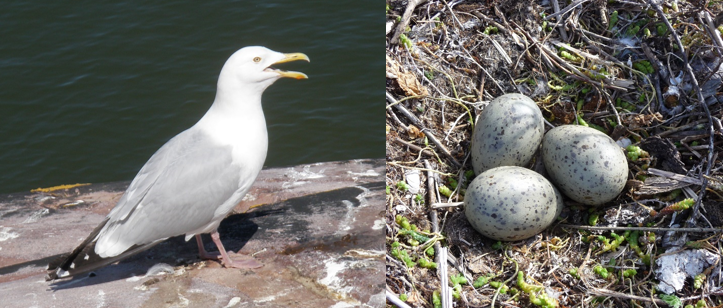
Figure 1. Herring gull (Larus argentatus) and eggs. Photo Credit: de Solla SR, Environment and Climate Change Canada.
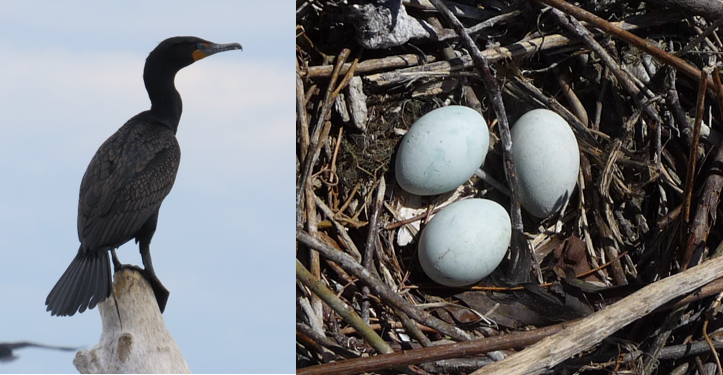
Figure 2. Double-crested cormorant (Phalacrocorax auritus) and eggs. Photo Credit: de Solla SR, Environment and Climate Change Canada.
Status and Trends
Herring Gulls
Up to 13 fresh herring gull eggs were collected from each of Fighting Island in the Detroit River and Middle Island in western Lake Erie during early incubation, late April - early May, most years, since 1974. However, herring gull eggs have been found only once since 2010 at Fighting Island. From 2015, cormorant eggs have been collected annually from the Detroit River. Eggs were analyzed individually from 1974 to 1986, but have been analyzed as a single pool of eggs at each site since 1987.
PCBs: Since 1974 (Middle Island) and 1978 (Fighting Island), PCB concentrations have greatly declined in herring gull eggs (Figure 3). In 2015, PCB concentrations were only 10% of the initial concentration in eggs from Fighting Island and 28% of the initial concentration in eggs from Middle Island in 2018. Generally, PCBs declined as a first order decay rate; however, PCB levels at Middle Island have been unchanging for the last decade. PCBs in eggs from Middle Island had the lowest rate of decline of any colony monitored within the five Great Lakes (de Solla et al., 2016). Since the early 1990s, concentrations in gull eggs were similar between the two colonies, but there were a couple of years with elevated PCBs in eggs in the late 2000s at the Middle Island colony.
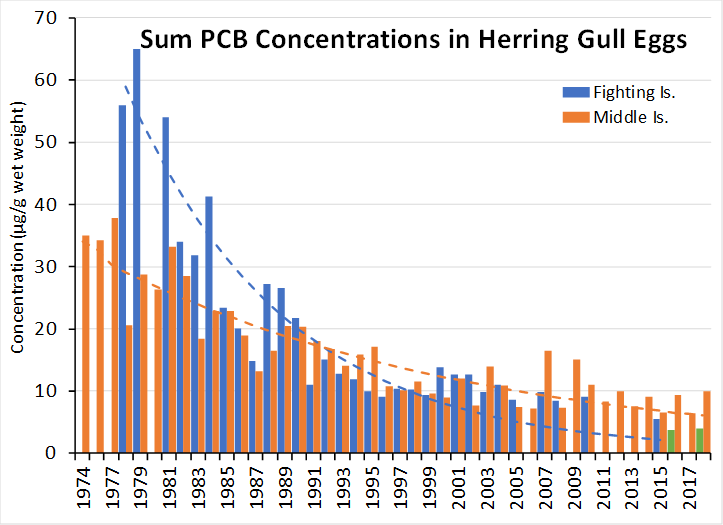
Figure 3. Sum PCBs in herring gull eggs from Detroit River (Fighting Island) and western Lake Erie (Middle Island) from 1974-2018. The green bars indicate PCB concentrations in cormorant eggs from Fighting Island in 2016 and 2018 since no data are available for herring gulls.
DDE and other pesticides: Organochlorine pesticides such as DDE, a metabolite of DDT, were monitored annually. Similar to PCBs, DDE concentrations have greatly declined (Figure 4). In 2015, DDE concentrations were only 12% of the initial concentration in eggs from Fighting Island and 14% of the initial concentration in eggs from Middle Island in 2018. DDE declined as a first order decay rate, but have been unchanging for the last decade. Concentrations were generally similar between Middle Island and Fighting Island, but there were a couple of years with elevated DDE concentrations in eggs in the late 2000s at the Middle Island colony. Other organochlorine pesticides, such as chlordane, hexachlorobenzene, and dieldrin show similar patterns, albeit at lower concentrations than DDE.
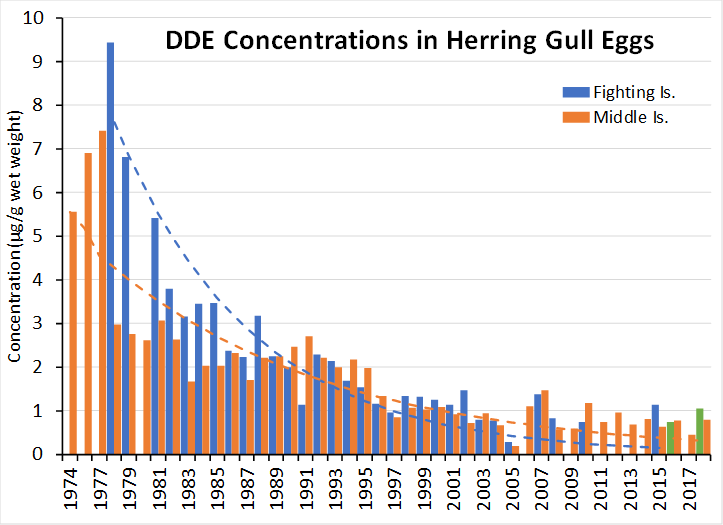
Figure 4. DDE in herring gull eggs from Detroit River (Fighting Island) and western Lake Erie (Middle Island) from 1974-2018. The green bars indicate PCB concentrations in cormorant eggs from Fighting Island in 2016 and 2018 since no data are available for herring gulls.
Mercury (Hg): Unlike organic contaminants, Hg concentrations have declined only slightly in gull eggs since the 1970s (Figure 5). Of note, concentrations increased in eggs from Middle Island between 2005 and 2010 by nearly three times, before declining to more typical levels. The increase in Hg in the late 2000s was even more pronounced in fish (Blukacz-Richards et al., 2017). No such increase was found in eggs from Fighting Island during this period.
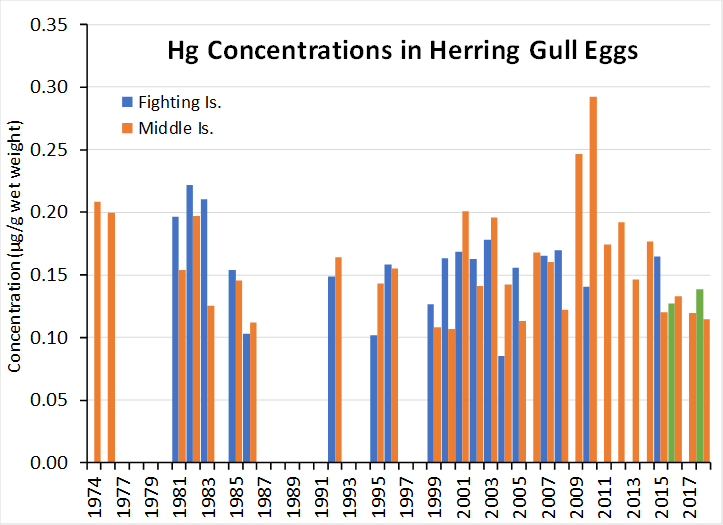
Figure 5. Mercury in herring gull eggs from Detroit River (Fighting Island) and western Lake Erie (Middle Island) from 1974-2018. The green bars indicate PCB concentrations in cormorant eggs from Fighting Island in 2016 and 2018 since no data are available for herring gulls.
Polychlorinated naphthalenes: Polychlorinated naphthalenes (PCNs) were retrospectively measured in herring gull eggs from Fighting Island and Middle Island, roughly every five years from 1980 to 2013. We include data from whole body walleye (Sander vitreus) for comparative purposes (from McGoldrick et al., 2018). Like PCBs, concentrations initially declined from 1980 to 1995; however, from 1995 to the early 2000s, PCNs increased both in gulls but especially walleye, before subsequently declining (Figure 6). Concentrations were initially higher in gull eggs from Fighting Island, but from 1995 and onwards, concentrations were more similar between the two colonies. The Detroit River appears to be the ultimate source of PCNs in gulls for most colonies downstream as far as Kingston (Figure 7).
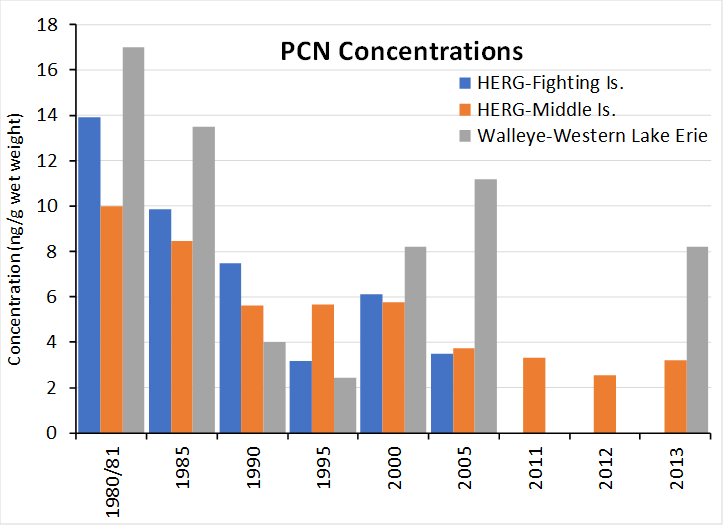
Figure 6. Sum PCNs in herring gull eggs and walleye from Detroit River (Fighting Island) and western Lake Erie (Middle Island) from 1980-2013.
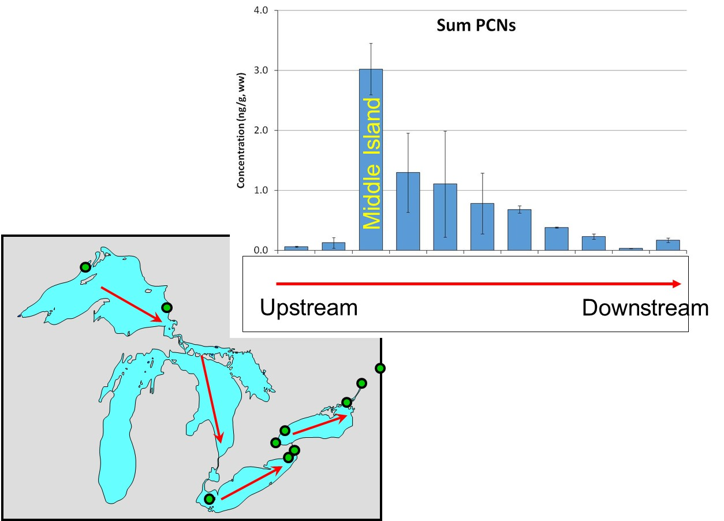
Figure 7. Sum PCNs in herring gull eggs from the Great Lakes in the order from upstream to downstream colonies, in 2011-2013.
Double-Crested Cormorants
PCBs: PCB concentrations were higher in double-crested cormorant eggs from Fighting Island than those from Middle Island from 2015 to 2018 (Figure 8). There is no evidence of declines in PCB concentrations at the two colonies over the short time period from 2015 to 2018. It is possible that PCBs may be increasing at Middle Island, but more years of sampling are required to determine any such trend. PCB concentrations in cormorants were on average one-third of those in gulls based on comparisons in eggs collected from Middle Island from 2015 to 2018.
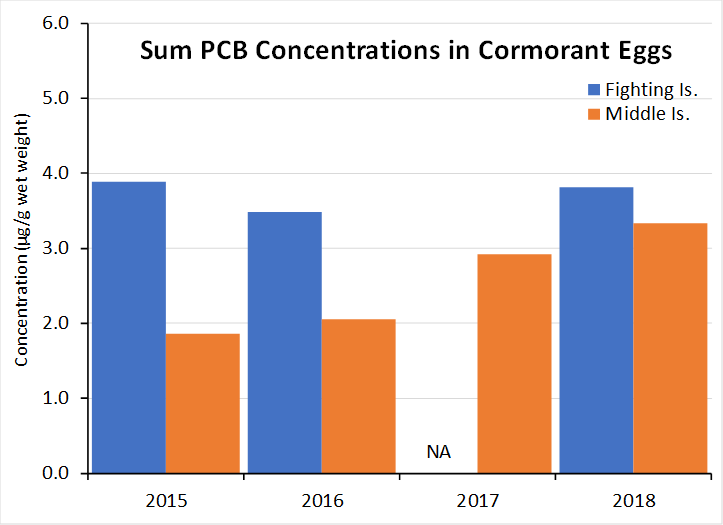
Figure 8. Sum PCB in double-crested cormorant eggs from Detroit River (Fighting Island) and western Lake Erie (Middle Island) from 2015-2018. NA indicates that no data are available.
DDE and other pesticides: Like PCBs, concentrations of DDE were higher in cormorant eggs from Fighting Island than those from Middle Island (Figure 9). Trends in other organochlorine pesticides were similar to DDE, although at lower concentrations overall. DDE levels in cormorant eggs were similar to those in herring gull eggs.
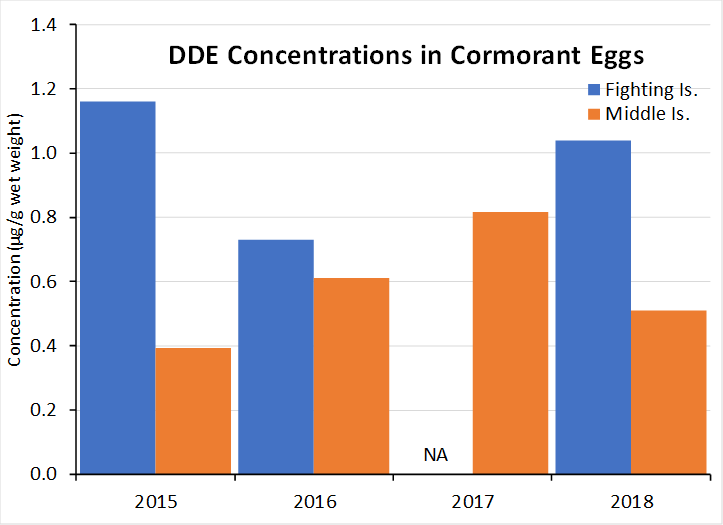
Figure 9. DDE in double-crested cormorant eggs from Detroit River (Fighting Island) and western Lake Erie (Middle Island) from 2015-2018. NA indicates that no data are available.
Mercury (Hg): Concentrations of Hg were higher in cormorant eggs from Fighting Island than those from Middle Island (Figure 10). Hg concentrations in cormorant eggs were similar to those in herring gull eggs.
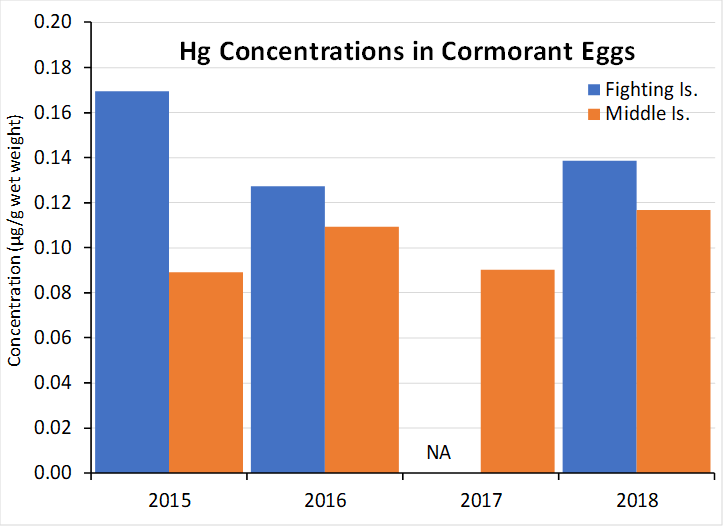
Figure 10. Mercury in double-crested cormorant eggs from Detroit River (Fighting Island) and western Lake Erie (Middle Island) from 2015-2018. NA indicates that no data are available.
Emerging Compounds
Although not analyzed on an annual basis, contaminants of emerging concern are also analyzed in gull eggs on a regular (monitoring) or irregular (surveillance) basis. Substituted diphenylamine antioxidants (SDPAs) and benzotriazole UV stabilizers (Lu et al., 2018), organophosphate triester flame retardants (Su et al., 2015), perfluorinated sulfonates and perfluorinated carboxylic acids (Letcher et al., 2015) have been analyzed in eggs, including those from Middle Island. Unlike most legacy contaminants such as PCBs and organochlorine pesticides, some of these contaminants were either stable or increasing, reflecting their current or recent use.
Management Considerations
The apparent increase of PCNs concentrations in both gulls and fish (McGoldrick et al., 2018) observed in Lake Erie after 1995 combined with the high levels of PCNs in suspended sediments in the Detroit River are almost certainly linked. Further, PCB concentrations in gull eggs from the colony immediately downstream of the Detroit River (Middle Island, western Lake Erie) have the lowest rate of decline of all colonies in the Great Lakes (de Solla et al., 2016). In 1993, large scale remediation of contaminated sediments was initiated within the Detroit River Area of Concern, and nearly 1,000,000 m3 of contaminated sediments were removed from the Detroit River watershed (Zarull and Hartig, 2007). These data suggest that gulls and fish collected downstream of the Detroit River had increased body burdens following resuspension of contaminated sediments from remediation projects in the Detroit River conducted from the mid-1990s to mid-2000s (McGoldrick et al., 2018). Similarly, elevated Hg concentrations found in gull eggs from the Middle Island colony in some years and in fish (Blukacz-Richards et al., 2017) in the late 2000s may have also been have been associated with these events. These findings support the use of fish and wildlife indicator species as important tools for monitoring environmental conditions following such activities.
Interpretations of Body Burdens
Measurements of body burdens in colonial waterbirds integrate the net effect of factors such as bioavailability of contaminants, food chain dynamics, and chemical partitioning behaviour in the environment. One of the advantages of using colonial waterbirds as indicators is that their rates of elimination of body burdens for persistent organic pollutants (POPs) are generally much faster than the rates of environmental degradation; hence changes in body burdens reflect changes in the bioavailability of POPs. Degradation half-lives in sediment of the PCB congeners typically found in herring gull eggs range between 10 to 19 years in sediment (Sinkkonen and Paasivirta, 2000). Conversely, the half-life of p,p’-DDE in herring gulls was estimated to be 264 days (Norstrom et al., 1986), with half-lives for PCBs likely to be similar. Hence, colonial waterbirds respond faster to inputs of POPs through their diet than the degradation rate of POPs in the general environment. The half-lives of contaminants in gull eggs in the Great Lakes (de Solla et al., 2016) reflect rates consistent to losses in the environment, rather than metabolic loss.
References
- Blukacz-Richards, E.A., Visha A., Graham M.L., McGoldrick D.L., de Solla S.R., Moore D.J., Arhonditsis G.B. 2017. Mercury levels in herring gulls and fish: 43 years of spatio-temporal trends in the Great Lakes. Chemosphere 172: 476-487.
- de Solla S.R., Weseloh D.V.C., Hughes K.D., Moore D.J. 2016. Forty- year decline of organic contaminants in eggs of herring gulls (Larus argentatus) from the great lakes, 1974 to 2013. Waterbirds 39: 171-180.
- Letcher R.J., Su G., Moore J.N., Williams L.L., Martin P.A., de Solla S.R., Bowerman W.W. 2015. Perfluorinated sulfonate and carboxylate compounds and their precursors in recent eggs of herring gulls from across the Laurentian Great Lakes of North America: distribution and exposure implications. Sci Total Environ. 538: 468-477.
- Lu Z., De Silva A.O., McGoldrick D.J., Peart T.E., Cook C., Tetreault G.R., Martin P.A., de Solla S.R. 2018. Substituted diphenylamine antioxidants and benzotriazole UV stabilizers in aquatic organisms in the Great Lakes of North America: terrestrial exposure and biodilution. Environ. Sci. Tech. 52: 1280-1289.
- McGoldrick D.J., Pelletier M., de Solla S.R., Martin P.A. 2018. Legacy of legacies: Chlorinated naphthalenes in lake trout, walleye, herring gull eggs and sediments from the Laurentian Great Lakes indicate possible resuspension during contaminated sediment remediation. Sci. Total Environ. 634: 1424-1434.
- Norstrom R.J., Clark T.P., Jeffrey D.A., Won H.T., Gilman A.P. 1986. Dynamics of organochlorine compounds in Herring Gulls (Larus argentatus): I. Distribution and clearance of [14C]DDE in free‐living herring gulls (Larus argentatus). Environ. Toxicol. Chem. 5: 41-48.
- Sinkkonen S., Paasivirta J. 2000. Degradation half-life times of PCDDs, PCDFs and PCBs for environmental fate modeling. Chemosphere 40: 943-949.
- Su G., Letcher R.J., Moore J.N., Williams L.L., Martin P.A., de Solla S.R., Bowerman W.W. 2015. Spatial and temporal comparisons of legacy and emerging flame retardants in herring gull eggs from colonies spanning the Laurentian Great Lakes of Canada and United States. Environ. Res. 142: 720-730.
- Zarull M.A., Hartig J.H. 2007. Contaminated sediment remediation. In: Hartig J.H., Zarull M.A., Ciborowski J.J.H., Gannon J.E., Wilke E., Norwood G. (Eds). State of the Strait: Status and Trends of Key Indicators. Univ. of Windsor, pp. 305–308 Great Lakes Institute for Environmental Research Occasional Publication No. 5.
Contact Information regarding Contaminants in Colonial Waterbird Eggs
Shane de Solla
Environment and Climate Change CanadaE-mail: shane.desolla@canada.ca
Kimberley Hughes
Broadwing Biological ConsultingE-mail: kimberleyhughes@rogers.com